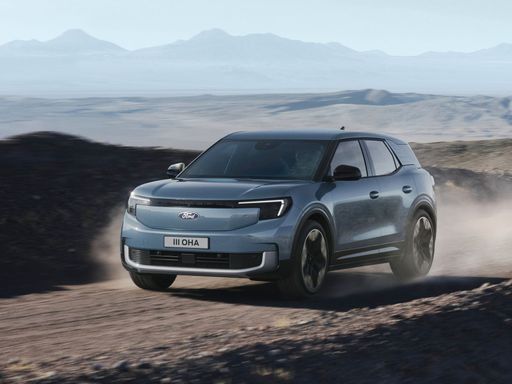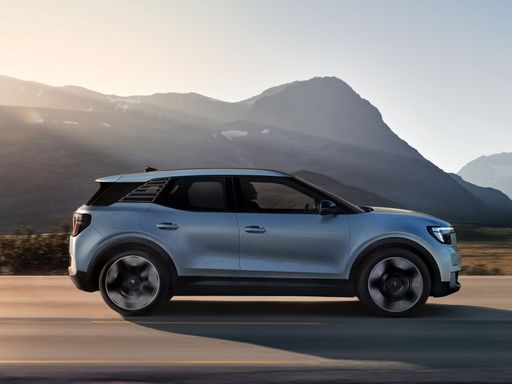Ford Explorer EV vs SsangYong Torres – Which car suits you better?
Everyday use, family trips or long-distance drives – here’s where the differences show.
Discover whether Ford Explorer EV or SsangYong Torres fits your lifestyle better.
Costs and Efficiency: Looking at overall running costs, both models reveal some interesting differences in everyday economy.
SsangYong Torres has a barely noticeable advantage in terms of price – it starts at 33800 £, while the Ford Explorer EV costs 34200 £. That’s a price difference of around 352 £.
In terms of energy consumption, the advantage goes to the Ford Explorer EV: with 14.50 kWh per 100 km, it’s noticeable more efficient than the SsangYong Torres with 18.70 kWh. That’s a difference of about 4.20 kWh.
As for range, the Ford Explorer EV performs clearly perceptible better – achieving up to 602 km, about 140 km more than the SsangYong Torres.
Engine and Performance: Power, torque and acceleration say a lot about how a car feels on the road. This is where you see which model delivers more driving dynamics.
When it comes to engine power, the Ford Explorer EV has a evident edge – offering 340 HP compared to 207 HP. That’s roughly 133 HP more horsepower.
In terms of top speed, the SsangYong Torres performs minimal better – reaching 194 km/h, while the Ford Explorer EV tops out at 180 km/h. The difference is around 14 km/h.
There’s also a difference in torque: Ford Explorer EV pulls clearly stronger with 679 Nm compared to 339 Nm. That’s about 340 Nm difference.
Space and Everyday Use: Whether family car or daily driver – which one offers more room, flexibility and comfort?
Both vehicles offer seating for 5 people.
In curb weight, SsangYong Torres is distinct lighter – 1498 kg compared to 1908 kg. The difference is around 410 kg.
In terms of boot space, the SsangYong Torres offers clearly perceptible more room – 703 L compared to 450 L. That’s a difference of about 253 L.
In maximum load capacity, the SsangYong Torres performs somewhat better – up to 1662 L, which is about 240 L more than the Ford Explorer EV.
When it comes to payload, Ford Explorer EV minimal takes the win – 585 kg compared to 552 kg. That’s a difference of about 33 kg.
Who wins the race?
The Ford Explorer EV proves to be is largely superior and therefore becomes our DriveDuel Champion!
Ford Explorer EV is the better all-rounder in this comparison.

Ford Explorer EV
Ford Explorer EV
The Ford Explorer EV marks a significant step forward in the brand's journey towards electrification, offering an impressive blend of performance and sustainability. This modern SUV features a sleek design complemented by advanced technology that enhances the driving experience. With a focus on comfort and innovation, the Explorer EV aims to redefine family travel for the electric age.
details @ electricexplorer.fordpresskits.com
@ electricexplorer.fordpresskits.com
 @ electricexplorer.fordpresskits.com
@ electricexplorer.fordpresskits.com
 @ electricexplorer.fordpresskits.com
@ electricexplorer.fordpresskits.com
SsangYong Torres
The SsangYong Torres stands out with its rugged design and robust stance, ideal for adventure enthusiasts seeking a reliable companion for off-road escapades. Inside, the vehicle offers a spacious and comfortable cabin equipped with modern features to enhance the driving experience. Its performance is geared towards delivering a smooth ride, making it versatile for both city driving and rural trails.
details

|
|
|
|
|
Costs and Consumption |
|
|---|---|
|
Price
34200 - 48800 £
|
Price
33800 - 44600 £
|
|
Consumption L/100km
-
|
Consumption L/100km
7.9 - 9.1 L
|
|
Consumption kWh/100km
14.5 - 17.2 kWh
|
Consumption kWh/100km
18.70 kWh
|
|
Electric Range
360 - 602 km
|
Electric Range
462 km
|
|
Battery Capacity
52 - 79 kWh
|
Battery Capacity
-
|
|
co2
0 g/km
|
co2
0 - 207 g/km
|
|
Fuel tank capacity
-
|
Fuel tank capacity
50 L
|
Dimensions and Body |
|
|---|---|
|
Body Type
SUV
|
Body Type
SUV
|
|
Seats
5
|
Seats
5
|
|
Doors
5
|
Doors
5
|
|
Curb weight
1908 - 2179 kg
|
Curb weight
1498 - 1618 kg
|
|
Trunk capacity
445 - 450 L
|
Trunk capacity
703 L
|
|
Length
4468 mm
|
Length
4700 mm
|
|
Width
1871 mm
|
Width
1890 mm
|
|
Height
1630 - 1639 mm
|
Height
1710 mm
|
|
Max trunk capacity
1417 - 1422 L
|
Max trunk capacity
1662 L
|
|
Payload
561 - 585 kg
|
Payload
552 kg
|
Engine and Performance |
|
|---|---|
|
Engine Type
Electric
|
Engine Type
Petrol, Electric
|
|
Transmission
Automatic
|
Transmission
Manuel, Automatic
|
|
Transmission Detail
Reduction Gearbox
|
Transmission Detail
Manual Gearbox, Automatic Gearbox, Reduction Gearbox
|
|
Drive Type
Rear-Wheel Drive, All-Wheel Drive
|
Drive Type
Front-Wheel Drive, All-Wheel Drive
|
|
Power HP
170 - 340 HP
|
Power HP
163 - 207 HP
|
|
Acceleration 0-100km/h
5.3 - 8.7 s
|
Acceleration 0-100km/h
-
|
|
Max Speed
160 - 180 km/h
|
Max Speed
191 - 194 km/h
|
|
Torque
310 - 679 Nm
|
Torque
280 - 339 Nm
|
|
Number of Cylinders
-
|
Number of Cylinders
4
|
|
Power kW
125 - 250 kW
|
Power kW
120 - 152 kW
|
|
Engine capacity
-
|
Engine capacity
1497 cm3
|
General |
|
|---|---|
|
Model Year
2024 - 2025
|
Model Year
2023 - 2024
|
|
CO2 Efficiency Class
A
|
CO2 Efficiency Class
G, A
|
|
Brand
Ford
|
Brand
SsangYong
|
What drive types are available for the Ford Explorer EV?
The Ford Explorer EV is available as Rear-Wheel Drive or All-Wheel Drive.
The prices and data displayed are estimates based on German list prices and may vary by country. This information is not legally binding.
